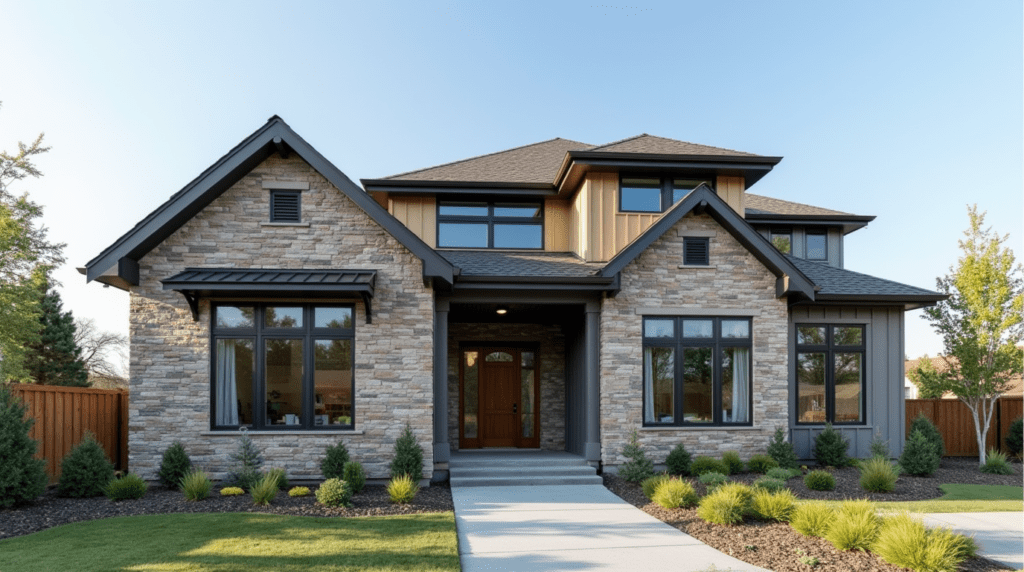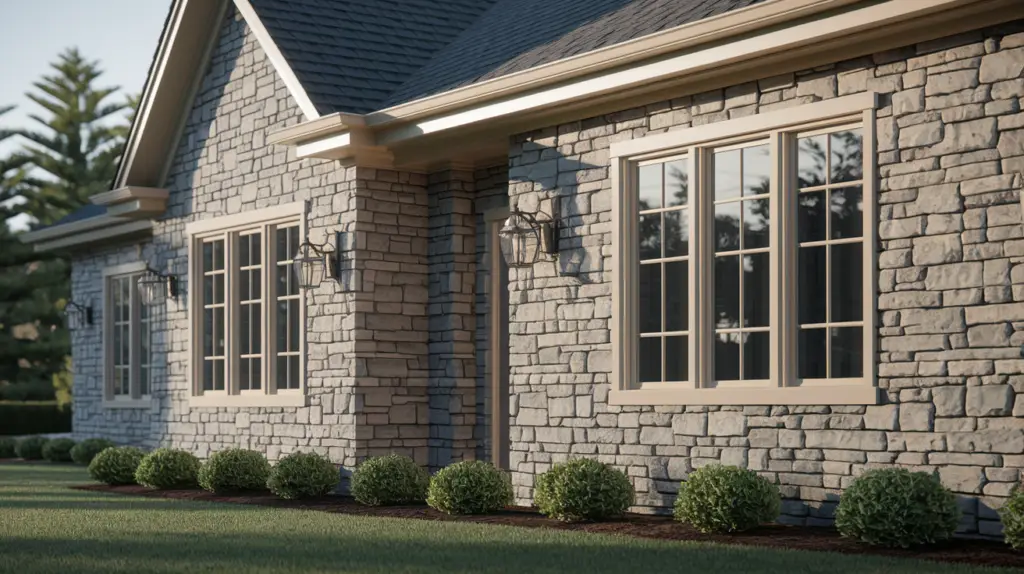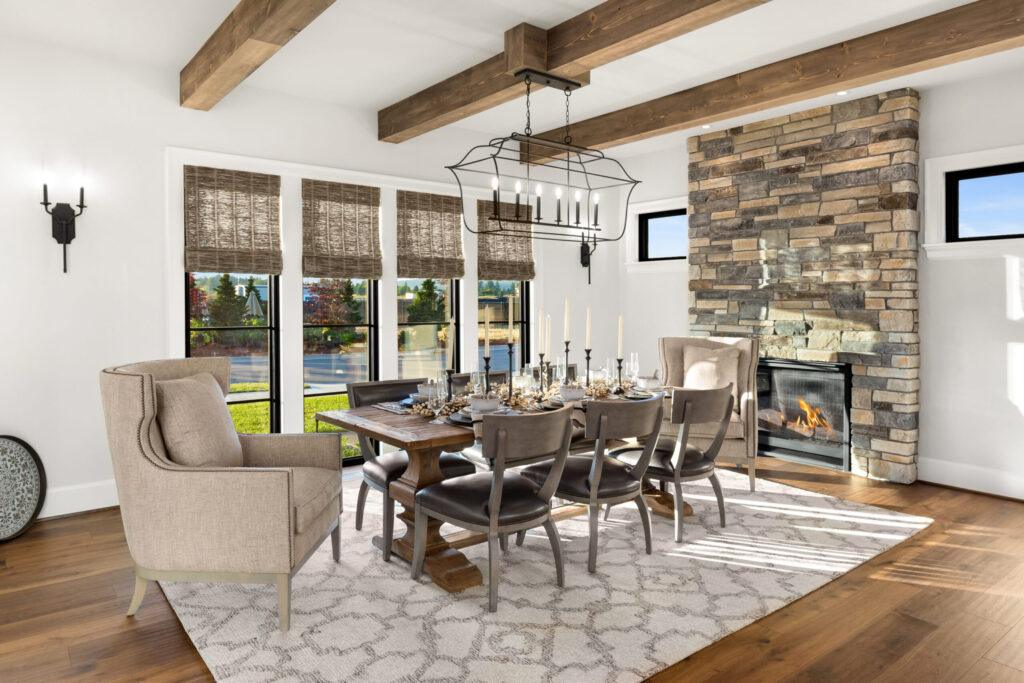First impressions matter, and your home’s exterior creates an immediate visual statement about your personal style and attention to detail. While traditional siding materials like vinyl, fiber cement, and wood have long dominated the market, thin stone wall cladding has emerged as a premium alternative that combines the timeless beauty of natural stone with modern installation advantages.
This innovative thin stone wall cladding solution allows homeowners to dramatically transform their property’s appearance without the structural challenges of traditional masonry. In this comprehensive guide, we’ll explore how thin stone cladding can elevate your home’s exterior, examining material options, installation techniques, design considerations, and the remarkable return on investment this upgrade can provide.

The Evolution of Exterior Stone Cladding
Before diving into specific applications and techniques, it’s worth understanding how thin stone cladding has revolutionized exterior stone applications:
From Traditional Masonry to Modern Systems
Traditional stone exteriors required:
- Substantial structural support due to stone’s immense weight
- Specialized masonry skills and extensive labor
- Significant material costs and waste
- Limited application possibilities due to weight constraints
Modern thin stone cladding systems have transformed this approach with:
- Stone panels typically 1/4″ to 1″ thick (versus 4″+ for traditional stone)
- Weight reductions of 60-80% compared to full-dimensional stone
- Simplified installation systems requiring less specialized labor
- Expanded application possibilities for various building types
According to Building Science Corporation, “The development of reliable thin stone cladding systems represents one of the most significant advancements in exterior building envelope technology of the past several decades.”
Environmental and Sustainability Advantages
Beyond practical construction benefits, thin stone cladding offers notable environmental advantages:
- Reduced raw material consumption through efficient stone cutting techniques
- Lower transportation energy due to significantly reduced weight
- Decreased carbon footprint compared to manufactured siding alternatives
- Exceptional longevity that eliminates frequent replacement cycles
- Natural thermal mass properties that contribute to energy efficiency
The Natural Stone Institute notes that stone cladding’s durability makes it one of the most sustainable exterior cladding options available, with life expectancies measured in decades rather than years.
Types of Thin Stone Wall Cladding
Several distinct systems have emerged for exterior Thin Stone Wall Cladding, each with specific advantages:
Adhered Stone Veneer Systems
Adhered systems attach thin stone directly to properly prepared wall surfaces:
- Application method: Stones adhered with modified thinset mortar
- Typical thickness: 3/4″ to 1-1/4″ including mortar bed
- Weight: Approximately 10-15 pounds per square foot
- Advantages: Cost-effective, suitable for many building types
- Considerations: Requires proper moisture management systems
These systems are particularly popular for residential applications and smaller commercial projects due to their relative simplicity and cost-effectiveness.
Mechanical Anchor Systems
These sophisticated systems use mechanical fasteners to secure stone panels:
- Application method: Stone panels attached with specialized clips and anchors
- Typical thickness: 3/4″ to 1-1/2″ stone panels
- Weight: Approximately 15-25 pounds per square foot
- Advantages: Superior moisture management, excellent durability
- Considerations: Higher cost, more complex installation
These systems are often specified for high-end residential and commercial applications where performance and longevity are paramount concerns.
Rainscreen Stone Systems
The most advanced approach incorporates stone into a rainscreen design:
- Application method: Stone panels installed with an air gap between stone and water-resistant barrier
- Typical thickness: 1″ to 2″ total system thickness
- Weight: Varies by specific system design
- Advantages: Superior moisture management, thermal performance, and durability
- Considerations: Highest cost, most complex installation
According to Architect Magazine, “Rainscreen systems represent the gold standard for exterior cladding performance, particularly in demanding climate conditions.”
Prefabricated Panel Systems
These innovative systems feature stone pre-mounted to backing panels:
- Application method: Factory-assembled panels installed as complete units
- Typical thickness: 1″ to 2″ depending on system
- Weight: Typically 8-12 pounds per square foot
- Advantages: Rapid installation, consistent quality, reduced on-site labor
- Considerations: Limited customization, higher material costs
These systems are gaining popularity for projects where installation speed and consistency are priorities.
Popular Stone Types for Exterior Cladding
The choice of stone significantly impacts both aesthetics and performance:
Granite
Granite thin cladding offers exceptional durability and resistance to environmental stressors:
- Appearance: Speckled or crystalline texture with consistent coloration
- Durability: Exceptional resistance to freeze-thaw cycles and acid rain
- Maintenance: Minimal requirements with excellent stain resistance
- Applications: Ideal for severe weather regions and high-traffic areas
- Considerations: Higher cost, limited color range primarily in grays and blacks
Granite’s exceptional hardness makes it particularly suitable for regions with harsh weather conditions or coastal environments.
Limestone
Limestone thin cladding provides a refined, elegant appearance:
- Appearance: Smooth, consistent texture with subtle natural variations
- Durability: Good performance in moderate climates with proper sealing
- Maintenance: Requires periodic sealing and gentle cleaning methods
- Applications: Well-suited for traditional and formal architectural styles
- Considerations: More susceptible to acid rain and pollution in urban environments
Limestone’s refined appearance makes it particularly popular for classical and European-inspired home designs.
Sandstone
Sandstone thin cladding offers warm, earthy aesthetics:
- Appearance: Distinctive layered texture with warm earth tones
- Durability: Varies significantly by specific variety and density
- Maintenance: Requires proper sealing and periodic reapplication
- Applications: Excellent for desert, southwestern, and rustic designs
- Considerations: More porous varieties may require additional protection
Sandstone’s warm coloration makes it particularly effective for creating welcoming, earth-connected exteriors.
Quartzite
Quartzite thin cladding combines beauty with exceptional performance:
- Appearance: Crystalline sparkle with marble-like veining
- Durability: Excellent resistance to weathering and UV exposure
- Maintenance: Minimal requirements with natural stain resistance
- Applications: Versatile for both traditional and contemporary designs
- Considerations: Premium pricing, limited availability in some regions
Quartzite has gained popularity for high-end residential applications due to its combination of visual appeal and exceptional durability.
Slate
Slate thin cladding offers distinctive texture and rich coloration:
- Appearance: Distinctive cleft texture with rich, deep coloration
- Durability: Excellent weather resistance with proper installation
- Maintenance: Minimal requirements with natural resistance to staining
- Applications: Particularly effective for contemporary and transitional designs
- Considerations: Some varieties may experience color fading with UV exposure
Slate’s distinctive texture makes it particularly effective for creating accent walls and focal points in exterior designs.
Design Approaches for Exterior Stone Cladding
Thin stone cladding offers remarkable design flexibility for exterior applications:
Full Facade Applications
Covering the entire home exterior with stone creates a dramatic, cohesive appearance:
- Visual impact: Maximum transformation with consistent material language
- Design considerations: Requires careful attention to transitions at openings
- Investment level: Highest initial cost with maximum property value impact
- Architectural styles: Particularly effective for craftsman, rustic, and traditional designs
According to Remodeling Magazine’s Cost vs. Value Report, stone veneer exterior upgrades consistently rank among the highest ROI exterior improvements, often returning 90-95% of project costs upon resale.
Accent Wall Applications
Strategic use of stone on select exterior walls creates visual interest while managing budget:
- Visual impact: Creates focal points and architectural emphasis
- Design considerations: Requires thoughtful material transitions
- Investment level: Moderate cost with significant visual impact
- Architectural styles: Particularly effective for contemporary and transitional homes
Accent applications are particularly effective for highlighting architectural features like entryways, gables, or chimney structures.
Mixed Material Approaches
Combining stone with other exterior materials creates dynamic, layered designs:
- Stone + wood: Creates warm, natural aesthetic with textural contrast
- Stone + metal: Offers contemporary appeal with traditional elements
- Stone + stucco: Provides Mediterranean or southwestern character
- Stone + glass: Creates dramatic modern contrast between opacity and transparency
These mixed material approaches allow for creative expression while managing budget and highlighting architectural features.
Architectural Feature Enhancement
Using stone to highlight specific architectural elements:
- Entry surrounds: Creating welcoming focal points
- Column wraps: Adding substance to structural elements
- Foundation facing: Visually anchoring the home to its site
- Chimney cladding: Transforming utilitarian elements into design features
These targeted applications maximize visual impact while minimizing material costs.
Installation Considerations
Proper installation is crucial for both appearance and long-term performance:
Structural Preparation
Even lightweight stone cladding requires appropriate structural support:
- Verify wall structure can support the added weight (typically 10-15 lbs/sq ft)
- Ensure proper attachment to structural framing members
- Address any existing moisture issues before cladding installation
- Consider additional insulation integration during the renovation
According to Building Science Corporation, “Exterior renovations provide an excellent opportunity to improve the building envelope’s thermal performance and moisture management.”
Moisture Management
Proper moisture control is essential for long-term performance:
- Weather-resistant barrier: High-quality housewrap or building paper
- Proper flashing: Around all penetrations, windows, and doors
- Drainage plane: Providing a path for incidental moisture to exit
- Ventilation gap: In rainscreen systems to promote drying
These moisture management details are critical for preventing costly water damage and ensuring the cladding system’s longevity.
Climate-Specific Considerations
Installation details should be adapted to local climate conditions:
- Cold climates: Proper insulation integration and freeze-thaw resistant materials
- Hot, humid climates: Enhanced moisture management and mold prevention
- Coastal environments: Corrosion-resistant fasteners and salt-resistant stone types
- High wind regions: Enhanced mechanical attachment and corner reinforcement
Working with professionals familiar with local building conditions ensures appropriate system selection and detailing.
Professional vs. DIY Installation
While some thin stone systems are marketed as DIY-friendly, consider these factors:
- Project scale: Small accent areas may be DIY-appropriate; full facades typically require professional installation
- Technical complexity: Moisture management details require technical knowledge
- Equipment requirements: Proper cutting tools and scaffolding for larger projects
- Warranty considerations: Many manufacturers require professional installation for warranty coverage
For most homeowners, professional installation provides value through proper technique, efficiency, and long-term performance assurance.
Maintenance and Longevity
One of thin stone cladding’s primary advantages is its exceptional durability and minimal maintenance requirements:
Routine Maintenance
Basic care ensures your stone cladding maintains its beauty:
- Annual gentle cleaning with appropriate stone-safe cleaners
- Periodic inspection for any loose stones or mortar deterioration
- Vegetation management to prevent excessive moisture against stone
- Gutter maintenance to prevent water cascading over stone surfaces
Long-Term Care
With proper installation, long-term maintenance is minimal:
- Resealing may be recommended every 5-10 years for some stone types
- Inspect and maintain mortar joints in adhered systems
- Address any settlement cracks promptly to prevent moisture intrusion
- Consider professional cleaning every 5-10 years for optimal appearance
Compared to painted siding that requires repainting every 5-7 years or vinyl that deteriorates with UV exposure, stone cladding offers exceptional longevity with minimal intervention.
Cost Considerations and ROI
Thin stone cladding represents a premium exterior option with corresponding investment considerations:
Initial Investment Factors
Several variables influence project costs:
- Stone type and quality: Ranging from $8-30 per square foot for materials
- Installation system: Adhered systems typically cost less than mechanical or rainscreen systems
- Project complexity: Multiple corners, openings, and details increase labor costs
- Regional labor rates: Installation costs vary significantly by location
- Existing condition remediation: Addressing structural or moisture issues adds cost
For planning purposes, complete thin stone cladding projects typically range from $20-50 per square foot installed, depending on these variables.
Return on Investment
Despite the premium cost, stone cladding offers compelling ROI:
- Immediate property value increase: Typically 90-95% of project cost
- Enhanced marketability: Homes with stone exteriors often sell faster
- Reduced long-term maintenance costs: Minimal upkeep compared to other siding options
- Extended service life: 50+ years with proper installation versus 15-30 for alternatives
When evaluated over the full lifecycle, stone cladding often proves more economical than options with lower initial costs but higher maintenance requirements and shorter lifespans.
Complementary Design Elements
To maximize the impact of your thin stone cladding, consider these complementary exterior elements:
Architectural Lighting
Strategic lighting dramatically enhances stone’s textural beauty:
- Grazing fixtures: Positioned to cast light across the stone surface, highlighting texture
- Entry highlighting: Focused illumination that enhances stone details around doorways
- Landscape integration: Lighting that connects stone elements to the surrounding landscape
- Seasonal adaptability: Programmable systems that adjust for different occasions
Well-designed lighting extends the visual impact of stone cladding into evening hours while enhancing security and navigation.
Complementary Landscaping
Thoughtful landscaping enhances stone’s natural character:
- Native plantings: Connecting the built environment to the local ecosystem
- Vertical gardens: Creating living contrast against stone surfaces
- Hardscape coordination: Pathways and walls that complement the home’s stone
- Water features: Reflecting and enhancing stone’s natural beauty
These landscape elements create a cohesive design that extends the home’s aesthetic into the surrounding property.
Entry Features
The entryway offers prime opportunities for stone enhancement:
- Door surrounds: Framing the entry with detailed stonework
- Address markers: Integrated stone elements for house numbers
- Planters and pots: Complementary containers that enhance the stone palette
- Hardware selection: Door hardware and lighting fixtures that complement stone coloration
These details create a welcoming arrival experience that showcases your attention to design cohesion. For entry accessories that complement stone exteriors, explore our entryway collection.
Conclusion: The Transformative Impact of Thin Stone Cladding
Thin stone wall cladding represents one of the most impactful exterior renovations available to homeowners today. By combining the timeless beauty of natural stone with modern installation techniques, this innovative approach allows for dramatic transformation without the structural limitations and costs associated with traditional masonry.
From full facade applications that completely reinvent your home’s appearance to strategic accent walls that create visual interest, thin stone cladding offers versatile design possibilities for every architectural style and budget consideration. The exceptional durability, minimal maintenance requirements, and strong return on investment make stone cladding a compelling option for homeowners seeking lasting value.
As you consider your exterior renovation options, thin stone cladding deserves serious consideration for its unique combination of aesthetic appeal, performance benefits, and long-term value. With proper planning, quality materials, and expert installation, your stone cladding project can transform your home’s exterior into a stunning expression of natural elegance that will be enjoyed for decades to come.
Have you transformed your home’s exterior with thin stone cladding? We’d love to see your before and after photos and hear about your experience in the comments below!



